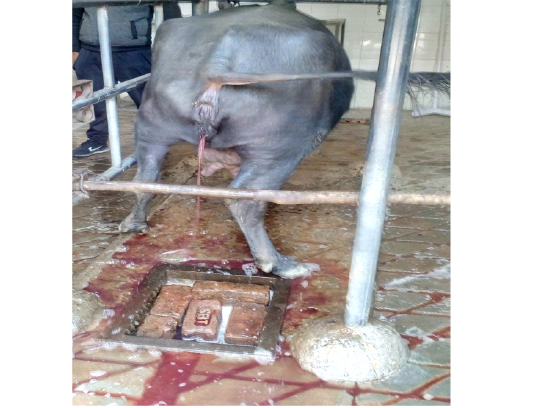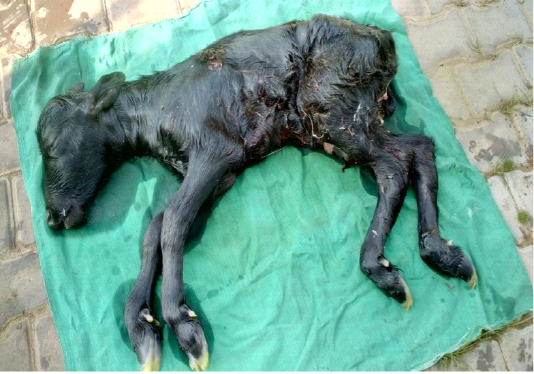Research Journal for Veterinary Practitioners
Case Report
Clinical Management of Hydroallantois in a Murrah Buffalo: A Case Report
Avaneesh Kumar Singh*, Jitendra Agrawal, Vikas Sachan, Anuj Kumar, Atul Saxena
Department of Veterinary Gynaecology and Obstetrics, College of Veterinary Science and Animal Husbandry, U.P. Pandit Deen Dayal Upadhyaya Pashu Chikitsa Vigyan Vishwavidyalaya Evam Go Anusandhan Sansthan, Mathura, Uttar Pradesh-281001, India.
Abstract | A full term pregnant Murrah buffalo in its third parity was presented to the clinic with the history of sudden increase in the size of abdomen in preceding 15 to 20 days. The animal was also showing reduced appetite and labored breathing. Per-vaginal examination revealed completely closed cervix. Based on history, trans-rectal ultrasonographic examination, case was diagnosed as hydroallantois. Subsequently, dilation therapy was given. A dead fetus in its posterior longitudinal presentation with ankylosis of fetlock joints was delivered. Animal recovered uneventfully.
Keywords | Buffalo, Hydroallantois, Induced parturition, Fetus, Ankylosis
Received | March 31, 2020; Accepted | May 11, 2020; Published | September 15, 2020
*Correspondence | Avaneesh Kumar Singh, Department of Veterinary Gynaecology and Obstetrics, College of Veterinary Science and Animal Husbandry, U.P. Pandit Deen Dayal Upadhyaya Pashu Chikitsa Vigyan Vishwavidyalaya Evam Go Anusandhan Sansthan, Mathura, Uttar Pradesh-281001, India; Email: [email protected]
Citation | Singh AK, Agrawal J, Sachan V, Kumar A, Saxena A (2020). Clinical management of hydroallantois in a murrah buffalo: a case report. Res J. Vet. Pract. 8(3): 42-44.
DOI | http://dx.doi.org/10.17582/journal.rjvp/2020/8.3.42.44
ISSN | 2308-2798
Copyright © 2020 Singh et al. This is an open access article distributed under the Creative Commons Attribution License, which permits unrestricted use, distribution, and reproduction in any medium, provided the original work is properly cited.
Introduction
Hydrallantois is usually considered as maternal abnormality, where the rapid and abnormal distension of abdomen occurs (Drivers and Peek, 2008) due to rapid accumulation of watery, amber color fluid inside the allantoic cavity over a period of 5 to 20 days in late gestation and is always giving suspicion for twin/triplet pregnancy (Morrow, 1986). It is commonly associated with either infectious disease or developmental defects of fetus (Kumar et al., 2019). The physiopathology of hydroallantois is related to the reduction of placental vascularization resulting in metabolic changes in the placental tissue and fetal membranes thereby accumulating fetal fluids (Kapadiya et al., 2018). The condition can be diagnosed by physical examination (vaginal/rectal) and ultrasonography in bovines (Sutaria et al., 2020). The management of these cases depends on the viability of the cow. If the animal is viable and near term, Caesarean surgery is advised, performed with care to enable the fluid to escape slowly and prevent hypovolaemic shock. (Noakes et al., 2019). The present case describes the successful management of the hydroallantois in a Murrah buffalo.
Case History and Observation
A Murrah buffalo in its third parity was presented to the Veterinary Clinical Complex DUVASU, Mathura with complaint of sudden bilateral distention of abdomen preceding 15 to 20 days. According to the owner, the animal was 10 month pregnant, the feed intake was reduced and animal was previously treated by paravet for bloat with no relief. On physical examination, buffalo was dull and depressed. Animal was showing shallow labored breathing. On trans- rectal examination, fetus and placentomes were not palpable and only extended fluid filled uterus was felt. This finding indicated the excessive accumulation of fluid inside the uterus. Vaginal examination revealed that cervix was closed. Texture of the cervix was soft. Trans-rectal ultrasonographic examination revealed only anechoic images of excessively filled fetal fluid. Based on history and clinical observations, the case was diagnosed as hydroallantois therefore decided to go for dilation therapy to induce the parturition.
Treatment
The buffalo was treated for cervical dilation using intramuscular injections (total dose) of cloprostinol sodium @ 500 µg, diethylstilbestrol @ 30 mg, betamethasone @ 40 mg and valethamid bromide @ 48 mg. Fluid therapy using 3 litres dextrose normal saline and 3 litre ringer’s lactate was administered intravenously. After 18 hours vaginal examination revealed dilation of cervix and the allantoic bag was punctured by inserting the index finger. Intravenous fluid infusion using 4 litres dextrose normal saline, 3 litres ringer’s lactate and 3 litres normal saline was done along with dexamethasone injection @ 40 mg was done to save the animal from hypovolaemic shock. On puncturing the allantois bag a large amount of non-sticky yellowish coloured fluid escaped out. Around 80-100 litre of total fluid drained out (Figure 1) and the size of abdomen reduced. Fetus was in posterior longitudinal presentation and no reflex was present. Both hind limbs were ankylosed at fetlock joint (Figure 2). A dead fetus was delivered per-vaginum by manual pulling using Mooreʼs obstetrical chain. Animal was also treated with intramuscular injections (total dose) of ceftriaxone @ 3 gm, meloxicam @ 125 mg, Oxytocin @ 75 IU, and intrauterine therapy with bolus oxytetracycline @ 3gm was also done. Inj. Calcium borogluconate 450 ml (250 ml slow i.v and 200 ml s.c) was administered. Animal recovered after follow up treatment of 5 days.
Discussion
Hydrollantois is one of the gestational disorders, that results due to increased production of a fluid closely resembling blood plasma within the allantoic sac (Kapadiya et al., 2018). The present communication reports successful management of a case of hydroallantois in Murrah buffalo. In the present case, cervix was closed and further the parturition was induced. In hydroallantois, accumulation of allantoic fluid is rapid due to placental abnormalities and possible interference with sodium metabolism at the cell level (Jackson, 1980). Hydroallantois could usually be associated with a diseased uterus in which most of the caruncles in one horn were not functional and atrophied and rest of the placentomes were enlarged, edematous and possibly diseased which led to formation of adventitious placenta (Drost, 2007). Excessive fluid accumulation in hydrallantois condition results abdominal distension due to accumulation of fluid in the allantoic sac which can cause pressure on lungs with resultant respiratory distress, difficulty in getting due to extra weight and sometimes recumbency with consequences of fatality to dam (Noakes et al., 2009). Hydrallantois is usually treated by terminating the pregnancy using prostaglandin F2α and corticosteroids (Manokaran et al., 2011) but the sudden removal of allantoic fluid leads to hypovolemic shock and collapse of the animal (Peiro et al., 2007). Cases of hydrallantois frequently retain the placenta and are at risk of metritis, with protracted convalescence and delayed conception (Noakes et al., 2019).
Conclusion
Parturition was induced in a Murrah buffalo affected with hydroallantois condition and it was successfully managed by administering a sufficient amount of fluid intravenously. A dead fetus with ankylosed hindlimbs was delivered in posterior longitudinal presentation by forced traction.
Acknowledgement
Authors are highly thankful to Head of the Department for providing us necessary facilities to carry out the work.
Conflict of Interest
Authors have no conflict of interest.
authors contribution
Avaneesh Kumar Singh and Jitendra Agrawal: Treatment and manuscript writing. Vikas Sachan: Manuscript writing & correction. Anuj Kumar: Case Diagnosis and manuscript correction. Atul Saxena: Case Diagnosis, Correction, Editing.
References








